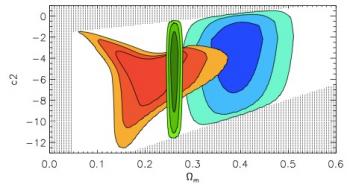Main publications from SNLS:
- Astier P. et al, ‘The Supernova Legacy Survey: Measurement of Omega_M, Omega_Lambda and w from the First Year Data Set’, 2006, A&A, 447,31
- Guy J. et al., 2010, ‘The Supernova Legacy Survey 3-year sample: Type Ia Supernovae photometric distances and cosmological constraints’, 2010, A&A, 523, A7
- Conley A. et al, ‘Supernova Constraints and Systematic Uncertainties from the First 3 Years of the Supernova Legacy Survey’, 2011, ApJS, 192,1.
- Betoule M. et al.,’Improved cosmological constraints from a joint analysis of the SDSS-II and SNLS supernova samples’, 2014, A&A, 568, A22
Publications from the DPhP group:
- Bazin G. et al, ‘The Core-collapse rate from the Supernova Legacy Survey’, 2009, A&A, 499, 653
- Palanque-Delabrouille N. et al, ‘Photometric redshifts for supernovae Ia in the Supernova Legacy Survey’, 2010, A&A, 514, A63
- Bazin G. et al, ‘Photometric selection of Type Ia supernovae in the Supernova Legacy Survey’, 2011, A&A, 534, A43
- Neveu J. et al, ‘Experimental constraints on the uncoupled Galileon model from SNLS3 data and other cosmological probes’, 2013, A&A, 555, A53
- Neveu J. et al, ‘First experimental constraints on the disformally coupled Galileon model’, 2014, A&A 569, A90
- Möller A. et al, ‘SNIa detection in the SNLS photometric analysis using Morphological Component Analysis’, 2015, JCAP, 04, 041M
- Neveu J. et al, ‘Constraining the ΛCDM and Galileon models with recent cosmological data’, arXiv:1605.02627, accepté pour publication dans A&A
- Möller A. et al., ‘Photometric classification of type Ia supernovae in the SuperNova Legacy Survey with supervised learning’, 2016, JCAP, 12, 008M

Constraint on two of the parameters of the tracker solution of the Galileon model. Constraints from type Ia supernovae (blue), from the cosmic microwave background combined with baryonic oscillations (green) and from the growth rate of structures (orange) strongly disagree. The tracker solution is thus rejected by data. But the general Galileon model is in good agreement with data, at the same level as the cosmological constant model. From Neveu et al., arXiv:1605.02627.
PhD thesis at DPhP:
V. Lusset (2003-2006), G. Bazin (2005-2008), J. Neveu (2011-2014), A. Möller (2012-2015).

